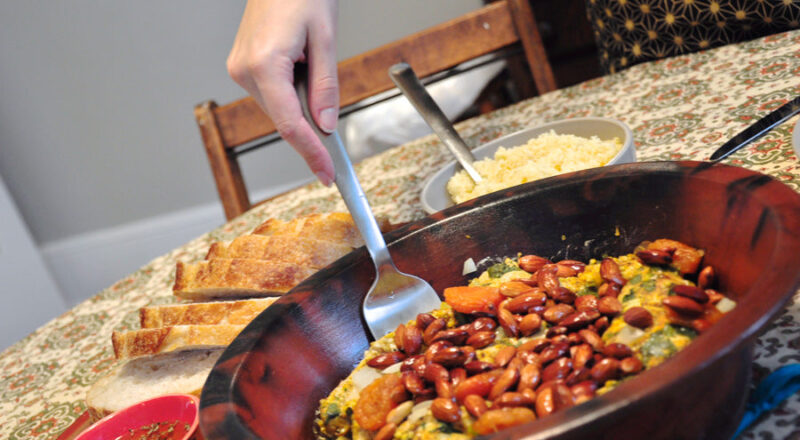Cooking with a tagine is a unique and enjoyable experience that can transform ordinary ingredients into extraordinary meals. The art of slow-cooking in this traditional North African pot allows flavors to meld beautifully, resulting in dishes that are both tender and flavorful. In this article, we will explore essential tips for creating perfect slow-cooked meals using a tagine that will delight both family and friends.

Understanding the Tagine
The tagine is a traditional cooking vessel from Morocco. It consists of two parts: a cone-shaped lid and a shallow base. This design helps circulate steam, making the food tender and full of flavor.
The Unique Design of the Tagine
The iconic cone-shaped lid is not just for aesthetics. It allows moisture to condense and drop back into the dish, keeping the ingredients moist. This self-basting feature is key to tagine cooking.
Materials and Varieties
Tagines are made of clay or ceramic and often come in beautiful, decorated designs. Clay tagines are porous and give more flavor, while ceramic tagines are more durable and easy to clean.
Preparing Your Tagine for Cooking
Before using your tagine, it’s important to prep it properly. This involves seasoning and ensuring the pot is suitable for your heat source.
Seasoning Your Tagine
If your tagine is made from unglazed clay, soak it in water for about 24 hours, then dry it thoroughly. Rub a light coat of oil on the inside and bake it to seal.
Choosing the Right Heat Source
Traditional tagines are used over charcoal, but modern ones can be used on gas or electric stoves. Always use a heat diffuser to prevent cracking.
Ingredient Selection for Slow-Cooked Meals
Choosing the right ingredients is crucial in tagine cooking. Fresh vegetables, high-quality meat, and aromatic spices are your best allies.
Best Meats for Tagine Cooking
Lamb, chicken, and beef are popular choices. These meats become exceptionally tender when slow-cooked, absorbing all the spices and juices.
Key Spices and Herbs
Cumin, coriander, paprika, and saffron are commonly used in tagine recipes. Fresh herbs like cilantro and parsley are great for garnishing.
Layering for Flavor
Layering is an important technique in tagine cooking. Place dense ingredients at the bottom and lighter ones on top.
Bottom Layers
Start with garlic, onions, and sliced potatoes. This foundation will impart flavor to the meat and veggies above.
Top Layers
Finish with softer vegetables like zucchini and bell peppers. Add liquids like broth or tomatoes to create steam.
Mastering the Slow-Cooking Process
Slow-cooking in a tagine requires patience, but the results are worth it. Keep the lid closed and let the flavors develop.
Temperature Control
Always use low to medium heat. Too much heat can lead to burning or drying out the food. Check with a thermometer if needed.
Cooking Time
Most tagine dishes require 1.5 to 2 hours of cooking. Lamb and beef may take longer for ideal tenderness.
Enhancing Your Tagine Creations
Finishing touches can elevate your dish from good to great. Consider adding dried fruits or a drizzle of honey for sweetness.
Using Dried Fruits
Apricots, dates, and prunes add a delightful contrast to savory dishes. They are often added during the last 30 minutes of cooking.
Garnishing Techniques
A sprinkle of toasted almonds or sesame seeds can add texture and a nutty flavor to your meal.
Storing and Reheating Leftovers
Tagine dishes not only taste better the next day but are also easier to store and reheat.
Proper Storage
Store leftovers in an airtight container in the fridge. Most tagine dishes will last up to three days.
Reheating Techniques
Reheat on a stove at low heat to preserve moisture. Add a splash of water or broth if necessary.
Exploring Tagine Recipes
If you are eager to try some recipes, you can find a variety of traditional options online. Websites like Recipe Tin Eats and All Recipes offer delightful choices to start your tagine journey.

Faqs
Can I use any pot as a substitute for a tagine?
While a Dutch oven can mimic a tagine, it wont replicate the unique steaming process fully.
What heat diffuser should I use?
A simple metal heat diffuser is effective. Ensure it spans the base of the pot.
What’s the best way to clean a tagine?
Avoid harsh detergents. Warm water and a gentle scrub will suffice. More tips on cleaning your kitchenware can be found here.
This article contains affiliate links. We may earn a commission at no extra cost to you.

